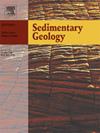华南陡山沱组碳酸盐沉积与早期成岩作用:研究末元古代的一个窗口
IF 2.9
2区 地球科学
Q1 GEOLOGY
引用次数: 0
摘要
具有独特沉积结构和结构的前寒武纪海洋碳酸盐岩为了解早期海洋的化学和生物条件提供了宝贵的见解。为了更好地了解接近元古代末期的浅海环境,本研究考察了中国南方浅滩边缘扬子台地埃迪卡拉系陡山沱组的碳酸盐岩沉积。这些模拟白云化岩石包括微球面扁纹岩相、颗粒岩-包覆岩相、微球面和微层状扁纹岩相、叠层石相和泥岩相,代表了从上斜坡和台地边缘环境到滩后潮外体系的过渡。颗粒岩-包岩相以早期文石和高镁方解石胶结物的大内碎屑为特征,具有直径约2 mm的放射状鲕粒,均表现出不同程度的微生物微晶化作用。潮旁相以潮间带的微球状-微层状平面岩和深水的叠层石和白云岩为主,微生物岩丰富。丰富的纤维状白云岩(束状和放射状长度缓慢,可达5毫米长)填充在潮滩相的空腔中,特别是在微生物席裂缝中。陡山沱组沉积发育在暖温带至热带陆架上,其早期快速的岩化作用表明,与现代条件相比,新元古代晚期的海水过饱和程度较高。陡山沱组碳酸盐岩物理性质的显著多样性反映了浅海环境下碳酸盐岩形成和溶解过程的分区化程度增强。这一转变与前寒武纪海洋化学和生物条件的演变相一致,微生物在白云岩降水中的作用日益受到重视。到元古代末期,台地碳酸盐岩地层更容易受到局部波动的影响,影响饱和状态和动力学条件,这在很大程度上受微生物活动的影响。本文章由计算机程序翻译,如有差异,请以英文原文为准。
Carbonate sedimentation and early diagenesis of the Doushantuo Formation, South China: A window into the terminal Proterozoic
Precambrian marine carbonates with distinct sedimentary fabrics and structures provide valuable insights into the chemical and biological conditions of early oceans. To better understand shallow marine environments approaching the terminal Proterozoic, this study examines carbonate deposits from the Ediacaran Doushantuo Formation across the shoal-rimmed Yangtze platform in South China. These mimetically dolomitized rocks comprise facies of micropeloidal leiolite, grainstone-packstone, micropeloidal and microlaminated leiolites, stromatolite, and mudstone, representing a transition from the upper slope and platform margin environments to the back-shoal peritidal system. The grainstone-packstone facies features large intraclasts of incipient aragonite and high-Mg calcite cements, along with radial ooids that are <2 mm in diameter, all exhibiting varying degrees of microbial micritization. The peritidal facies, marked by abundant microbialites, are dominated by micropeloidal-microlaminated leiolites from the intertidal zone and stromatolites and dolomudstones from deeper waters. Abundant fibrous dolomites (fascicular and radial length-slow, up to 5 mm long) fill cavities in the peritidal facies, particularly within microbial mat cracks. Developed on a warm-temperate to tropical shelf, the rapid early lithification of Doushantuo sediments indicates a high degree of seawater supersaturation during the late Neoproterozoic compared to modern conditions. The remarkable diversity in the physical properties of the Doushantuo carbonates reflects an increased compartmentalization of processes governing carbonate formation and dissolution in shallow marine environments. This shift corresponds with the evolving chemical and biological conditions of the Precambrian ocean, which increasingly emphasized microbial roles in dolomite precipitation. By the terminal Proterozoic, platform carbonate formation became more susceptible to local fluctuations affecting saturation states and kinetic conditions, largely influenced by microbial activity.
求助全文
通过发布文献求助,成功后即可免费获取论文全文。
去求助
来源期刊

Sedimentary Geology
地学-地质学
CiteScore
5.10
自引率
7.10%
发文量
133
审稿时长
32 days
期刊介绍:
Sedimentary Geology is a journal that rapidly publishes high quality, original research and review papers that cover all aspects of sediments and sedimentary rocks at all spatial and temporal scales. Submitted papers must make a significant contribution to the field of study and must place the research in a broad context, so that it is of interest to the diverse, international readership of the journal. Papers that are largely descriptive in nature, of limited scope or local geographical significance, or based on limited data will not be considered for publication.
 求助内容:
求助内容: 应助结果提醒方式:
应助结果提醒方式:


